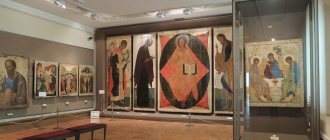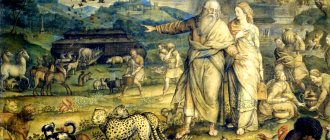A book occupies a certain place in the life of every person; for some it is the basis of morality and spirituality, for others it is the best assistant in the development of personal qualities and intellectual level.
In any case, the role of the book is enormous. But before becoming what we see a book today, it went through a huge evolutionary path from the origins of writing to the appearance of the first printed book.
Let's try to look in more detail at the history of the appearance and development of the book, both in Ancient Rus' and in the World.
The origin and development of writing
The predecessor of book creation and printing was naturally the origin and development of writing in the World.
The first mentions of this date back to the IV-III millennium BC. It was at this time that the first ancient Sumerian and Egyptian inscriptions appeared.
Much later - in the 9th century. Bulgarian inscriptions, Novgorod birch bark letters, as well as East Slavic calendar signs appear.
All these discoveries speak of the initial stage of development of various writing systems among many peoples of the world - Egyptians, Slavs, Sumerians and other peoples.
The book is an amazing repository of knowledge of human thought
The book is the greatest invention of mankind. The convenient and simple form has preserved the book through the centuries almost unchanged. The materials from which people made books changed, but the form in which the WORD was contained remained. Unfortunately, manuscripts burned, perished from wars, neglect, human stupidity and barbarism, but there were always people who sacredly protected the BOOK - this amazing repository of knowledge, human thought, faith and unbelief, doubts and victories, quests and achievements, love and despair, amazing moral heights and the abomination of obscurantism and hatred. Since the invention of the book, people have trusted it with their past and dreams for the future. The book is a universal repository of everything that makes up our culture and life itself. As Academician D.S. Likhachev , even if everything on Earth perishes, but libraries and books remain, hope for eternity will remain, because books will save life.
The significance of the book in Ancient Rus' is enormous. The Old Russian handwritten book has a thousand-year history. Appearing during the period of Christianization, the Book brought faith and word to people. The book became an integral part of ancient Russian medieval culture. It was the greatest value and an invariable attribute of Orthodox worship. The creation of a handwritten book was an act of enormous labor and strain of intellectual and moral strength. The book was and remains the most important part of the historical past of Rus', an outstanding monument of history and culture.
Ivan Fedorov's first printing press
The first equipment for book printing was extremely simple: a machine and several typesetting cash registers. The basis of the ancient printing press was a screw press. Ivan Fedorov’s machine has survived to this day.
You can see this value, touch history, and breathe in hoary antiquity at the Lviv Historical Museum. The weight of the machine is about 104 kg. The font was designed to resemble written letters. It was close to hand writing that was understandable to ordinary Russian people. The inclination to the right is maintained, the letters are even and of the same size. Margins and distances between lines are strictly observed. The title and capital letters were printed in red, and the main text in black. The use of two-color printing is the invention of Ivan Fedorov himself. Before him, no one in the world had used multiple colors on one printed page.
The quality of printing and materials is so impeccable that the first printed book, “The Apostle,” has survived to this day and is in the Moscow Historical Museum. In the 16th century there were two significant events for the history of Moscow, and subsequently for the history of Rus' - the construction of St. John the Blessed Cathedral in the capital and the creation of a printing press by Ivan Fedorov.
How were medieval books created?
In the Middle Ages, books were copied in special workshops called scriptoria. The first scriptorium was created by Cassiodorus (487-575) near the town of Szilats on the shores of the Gulf of Tarentum.
Some manuscripts copied in this workshop have survived to this day. The Irish played a very significant role in organizing scriptoria. Fleeing the destructive raids of the Norwegians and Danes, as well as spreading Christianity in Europe, they moved from the island of Hiera to neighboring islands and the continent. Their precious manuscripts were also with them. In 590, the monk of the Bangor monastery Columban (550 - 615) founded the Luxean monastery in Burgundy, where a scriptorium was organized. At the beginning of the 7th century. Queen Bathilda established a monastery at Corby near Amiens and invited Columbanus and the Luxean monks, among whom were book scribes, there.
This is how a large scriptorium arose in Corby, where hundreds of manuscripts were created. In 613, Columbanus went to Italy and, together with Irish monks, founded the monastery of Bobbio. Subsequently, the Bobbio library, created in the scriptorium of the same monastery, was considered one of the most remarkable in medieval Europe. In the VIII-IX centuries. Irish monks rushed deep into Europe and created their monasteries along the banks of the Meuse and Rhine rivers. By the end of the 11th century. they founded monasteries in Regensburg, Bamberg, Nuremberg. There also appeared their own scriptoria. In 910, a monastery was founded in Cluny (Burgundy), whose scriptorium successfully competed with Irish book-writing workshops.
The history of the emergence of book-writing workshops in Rus' still remains little studied. This is due, firstly, to the lack of direct sources that would directly talk about book writing in Rus', and, secondly, to the fact that complexes of handwritten books, external signs that would allow us to say that they were created in one workshop, not much has survived. And yet such complexes of books exist. The oldest scriptorium in Northwestern Rus' was a book-writing workshop that operated at the turn of the 11th-12th centuries. in the Novgorod Lazarev Monastery. Another scriptorium at the beginning of the 13th century. functioned under the department of Rostov Bishop Kirill I. Some data suggest that there were several book-writing workshops in Pskov in the 14th century.
Manuscripts of antiquity and the Middle Ages, as well as complexes of handwritten books that have common signs of origin (i.e., copied in the same scriptorium), form the subject of study by paleographers and codicologists. Paleography, whose name comes from two Greek words - “παλαιος” (ancient) and “γραφω” (I write), is the study of the external signs of written monuments recorded on soft material (primarily parchment and paper). Paleography does not deal with the content, but studies handwriting, format, binding, decorative features of manuscripts, with the task of correctly reading the text, dating undated written monuments, establishing the boundaries of different handwritings, determining the probable place of writing of the manuscript, if it is not directly indicated, and identifying falsifications. The name of another special historical discipline that studies manuscripts is codicology. The word "codicology" comes from the Latin "codex" (archaic - "caudex") - log, block, plank.
A specialist in the field of codicology (codicologist) studies the origin of a single handwritten book and their historical complexes (the production of books, their internal and external form (structure), writing technique, characteristic features of the products of a particular book-writing workshop, the migration of books, their existence, archival and library fate). Why does the name of the discipline that studies manuscripts come from the word for tablet? In ancient times, current records were made on special tablets made of wood or bone. Wooden tablets were coated with wax, and therefore they were called waxed or waxed (cerae, ceraculi, tabule, tabellae).
The wax was poured into special recesses of 0.5-1 cm, made in a rectangular board measuring 12x14 or 9x11 cm. Two tablets were placed one on top of the other with the waxed side inward, holes were made on the side and the tablets were fastened with a special cord. This is how the diptych turned out. Three tablets joined together were called a triptych. Sometimes there were four or more tablets - a polyptych (poliptycha) or a codex (codex). Tablets - ceras and codices - were used to record financial accounts, promissory notes, drafts, personal correspondence and as student copybooks. Wooden codes were destined to become the most ancient prototype of the modern book. And ancient and medieval manuscripts, written on papyrus and specially treated leather - parchment, in some sense reproduced the shape of waxed tablets joined together and are also called “codes”.
Homework assignment
Try to depict a page of a handwritten book. When decorating, use the same techniques that ancient Russian masters used.
Page of an Old Russian book
We use the following techniques for the layout of a handwritten page:
- The pattern is a miniature for the capital letter of each paragraph.
- Beautiful font, brown or black.
- A red line to highlight each new paragraph.
- Capitalization of letters.
Writing materials have evolved
One of the most ancient soft materials for writing was papyrus, which was made back in the era of the Egyptian Old Kingdom (III century BC) from a special type of reed that grew in the Nile Delta. A papyrus filled with text was called a volume (from the Greek word τομος - part) and special rollers made of wood, horn or bone were attached to it on both sides. Papyrus was rolled onto one of the rollers, producing a scroll (volumen). The scrolls were kept in special baskets or boxes (scrinium). In libraries they were placed on shelves (armarium).
Papyrus was replaced by parchment: scrolls were made from papyrus, in which the text was written on only one side. A book in the form of a codex required writing on both sides of a parchment sheet, for which papyrus was of little use. No more than ten books made in Europe from papyrus have survived. Parchment had a remarkable property: it could be reused many times. To do this, it was enough to wash off the original text with a damp sponge and polish the parchment sheet with pumice. After this, the text could be written again. Manuscripts written according to the erased original text are called palimpsests (from the Greek πάλιν - again and ψάω - scrape, erase).
Modern science makes it possible, using special methods, to read the erased original text of the palimpsest, that is, to find out which text was eliminated to write a new one. They began to write on parchment already in the 2nd century. BC. In the II - III centuries. parchment competed with papyrus, in the 4th century. already dominated. In the 8th century papyrus was largely replaced by parchment as a writing material. In general, the European Middle Ages have preserved to this day about 300 documents written on papyrus. Among them are 30 Merovingian charters and registers. Books on papyrus are very rare. After the 7th century papyrus was almost never used in book writing. However, in Southern Italy and Spain, where they made their own papyrus, it was used until the 12th century. The papal office, distinguished by a certain conservatism, wrote bulls on papyrus at the beginning of the 11th century: the last pope whose office issued the last papyrus bull is considered to be Benedict VIII (1012-1024).
The invention of parchment is associated with a legend told by Pliny the Elder with reference to Varro. According to legend, King Ptolemy of Egypt banned the export of papyrus to Pergamon, with which Egypt traditionally competed. In Pergamon, it was planned to create a huge library, which was supposed to surpass in its collection one of the wonders of the world - the famous Library of Alexandria. In response to the prohibitive measures of Ptolemy, the patron of the Pergamon book depository, King Eumenes III, encouraged the practice of improving the technique of processing the skins of the famous Eastern culture of diphthera. As a result, the Pergameans were the first to receive light yellowish-white sheets suitable for writing on both sides. The new material for writing was called “parchment” (περγαμηνά - Greek, pergamena, charta - Lat.).
The Romans called it “membrana” because the new writing material was very durable and at the same time elastic, which made it easy to bend. The technology for making parchment came to Rus' from Byzantium. To denote parchment, the word “haratya” (from the Greek χάρτης) was used, as well as “skin” and “veal”. In the XI-XIII centuries. books and letters in Rus' were written only on parchment. From the end of the 14th century. Along with parchment, they began to use imported paper, which was delivered from Italy and then France. Russia learned to make its own paper only in the 18th century. China is considered the birthplace of paper, from where it was exported to the East, Japan and the West. In Europe, paper became widespread already in the 12th century. The oldest document on paper is considered to be a manuscript written in Sicily in 1109. In 1209, the oldest paper mill began operating in Fabriano. In Germany, paper began to be used as a writing material starting in the 13th century.
Old Russian graffiti
Ivan's inscription. Cathedral of Hagia Sophia of the Wisdom of God (Sophia Cathedral), Veliky Novgorod. Mid-XI - early XII century. Photo: Alexey Gippius and Savva Mikheev / arzamas.academy
Rebus. Cathedral of Hagia Sophia of the Wisdom of God (Sophia Cathedral), Veliky Novgorod. Photo: hse.ru
The right column of the inscription about the murder of Prince Andrei Bogolyubsky. Spaso-Preobrazhensky Cathedral, Pereslavl-Zalessky, Yaroslavl region. Photo: historian.rf
On the walls of ancient Russian churches you can sometimes find texts and drawings that are carved directly on the stone. Scientists who study epigraphy - the science of ancient records - called them ancient Russian graffiti. Most of these notes are short texts: “Ivan wrote” or “Lord, help Your servant Andrey.”
Scientists have also found voluminous ancient Russian graffiti. For example, during the restoration of the Transfiguration Cathedral in Pereslavl-Zalessky, a record of the murder of Prince Andrei Bogolyubsky in 1174 was discovered. The text says: “On the month of June 29, Prince Andrei was killed by his parobki [servants - Approx. ed.], to him eternal memory, and to these [murderers—Approx. ed.] - eternal torment." The entry lists the names of previously unknown conspirators.
And from the graffiti in the St. George Cathedral of the Yuryev Monastery in Veliky Novgorod, it was possible to establish that the temple was built earlier than expected.
The exact number of records inside ancient Russian churches is unknown. Now they are found during the restoration of not only walls, but also floors of buildings. Most of the graffiti was found in the St. Sophia Cathedral in Novgorod. There is a whole wall with drawings, notes and even puzzles, which, most likely, were left by young servants of the temple in the 11th–12th centuries.
Slavic enlighteners
The question of the origin of writing in Rus' is very complex and controversial. This is due to the fact that scientists have a rather narrow range of sources, many of which do not have a sufficient degree of reliability and are not very representative. However, it is obvious that writing in Rus' spread widely only after its Christianization. Byzantium was the hotbed of writing, and Byzantine book and written culture penetrated into Rus' through Bulgaria, Macedonia, and, possibly, Serbia.
The origin of Slavic writing is associated with the activities of the Byzantine missionaries Constantine the Philosopher (Cyril) and Methodius . In the middle of the 9th century. they developed an alphabet for the Western Slavs and translated a number of liturgical books into Slavic. Thanks to the students and followers of Cyril and Methodius, this alphabet spread among the southern Slavs (in Bulgaria and Serbia), and later penetrated into the territory of Rus'. However, the circumstances surrounding the creation of the Slavic alphabet still remain unclear.
The oldest Slavic manuscripts were written not in one, but in two different alphabets - Cyrillic and Glagolitic. The question of which of these two alphabets is the most ancient and how the Cyrillic and Glagolitic alphabets relate to each other has not yet been completely resolved. This is due to the fact that Slavic manuscripts from the mid-9th century, when Cyril and Methodius were active, have not survived. Scientists have at their disposal monuments of writing from the end of the 9th - 10th centuries, and at that time both Cyrillic and Glagolitic alphabets were already used (i.e., both alphabets).
The written language of the Slavs (in fact, the language of the translations created by Cyril and Methodius) is the Old Church Slavonic language. The basis of the Old Church Slavonic language was one of the Bulgarian-Macedonian dialects of the South Slavic group. Gradually, Old Church Slavonic was adopted as a literary language by the Moravians, Pannonians, Bulgarians, Macedonians, Serbs, Croats and Russians. A distinctive feature of the Old Church Slavonic language is the presence in it only of a written form, common to all Slavic peoples. At the end of the 10th century, when Slavic writing and culture on the territory of the South Slavic states experienced a period of decline, the Old Church Slavonic language ceased to exist.
Under the influence of living local speech, the Church Slavonic language developed, which absorbed the phonetic features of the Bulgarian, Macedonian, Serbian and Old Russian languages. Already the earliest written monuments, written in Slavic, reflect features characteristic of the oral speech of their scribes. Local variants of the Church Slavonic language are usually called izvods. There are Middle Bulgarian, Serbian and Old Russian versions of the Church Slavonic language. In addition, monuments of the Czech and Moravian origins are known. Old Slavonic written monuments are the Book of Savvina of the 10th century, the Boyana Gospel of the late 11th century, the Enin Apostle of the 11th century, created on the territory of Bulgaria; Zograf Gospel of the 11th century, Assemanie Gospel of the 11th century, Ohrid Glagolitic sheets of the 11th century, created on the territory of Macedonia; Mariinsky Four Gospels of the 11th century, created on the territory of Serbia; as well as the Ostromir Gospel of 1056 - 1057, created on the territory of Ancient Rus'.
The oldest monuments of the Church Slavonic language of the Bulgarian translation include the Dobromir Gospel , the Ohrid and Slepchan Apostles of the 12th century, the Bologna Psalter of the early 13th century, and the Dobreishevo Gospel of the 13th century . The earliest monuments of the Serbian translation are considered to be the Miroslav Gospel of the 12th century, the Vukanovo Gospel of the 13th century, and the Sishatovac Apostle of 1324. The oldest manuscripts of the Czech translation are the Prague Glagolitic fragments of the 11th century . Scientists consider the earliest codices of the Russian translation to be the Arkhangelsk Gospel of 1092, the Galician Gospel of 1144, as well as the Chudovskaya and Evgenievskaya explanatory Psalters of the 11th century . The Church Slavonic language became most widespread in Rus', where it served as a literary language until the 18th century.
The earliest surviving codices written in Glagolitic alphabet are considered to be the Kyiv Glagolitic Sheets (Kiev Missal) at the turn of the 10th-11th centuries), which are a Slavic translation of the Latin Missal (from “mass” - mass). The oldest Cyrillic manuscript is the so-called Savvina book (Gospel aprakos short) from the turn of the 10th (?) - 11th century. V. The codex got its name from records mentioning priest Savva, probably one of the scribes.
In Macedonia and Bulgaria, the Glagolitic alphabet took root very easily. However, in Bulgaria, the more elegant and simple Cyrillic alphabet gradually replaced the Glagolitic alphabet. From the 12th century the round “Bulgarian” Glagolitic alphabet practically ceases to exist. The angular “Croatian” Glagolitic alphabet was used at the beginning of the 20th century. In Rus', the Glagolitic alphabet did not become widespread, although in eight Old Russian Cyrillic manuscripts of the 11th - 13th centuries. Glagolitic styles were used in individual words and even phrases, replacing, as a rule, Cyrillic ones. Six Glagolitic inscriptions on Old Russian Cyrillic codes and no more than a dozen graffiti inscriptions have been preserved. They allow us to talk about the Glagolitic alphabet of the 11th-13th centuries. as a manifestation of the influence of southern and Western Slavic written culture, which did not develop on Russian soil.
The oldest parchment manuscript that has come down to us, written in Russia and having an exact date of creation, is the Ostromir Gospel of 1056 - 1057.
This codex, rewritten by Deacon Gregory for the Novgorod mayor Ostromir-Joseph, was for a long time considered not only the oldest accurately dated Russian, but also the oldest surviving, accurately dated Slavic manuscript. With the discovery of the wooden Novgorod psalter, Slavic-Russian codicology received at its disposal a manuscript older than the parchment Ostromir Gospel. A manuscript created in the first decade after the baptism of Rus'.
All handwritten books in Rus' had a certain type of handwriting
All handwritten books and charters in Rus' are written in one of three types of handwriting - charter, semi-charter or cursive. Ustav is the most ancient type of handwriting, in which manuscripts were written during the era of parchment dominance, i.e. in the 11th - 14th centuries. The charter is understood as a solemn letter in which all elements of the letters are written exclusively correctly and clearly. Letters written in standard handwriting, as a rule, fit entirely between the upper and lower boundaries of the lines. Each letter fits freely into the square because its height is equal to its width. Scribes who wrote by rule avoided slanting letters, so all vertical elements were written strictly perpendicular to the line. In the 14th century, the charter began to be replaced by another type of handwriting - semi-charter. In ancient Russian manuscripts it appeared along with paper. Poluustav was quite widespread back in the 17th century, although it was then used mainly for writing books.
Certificates have been issued since the 15th century. began to be written in cursive. Like the charter, the semi-ustav remained a two-line letter, but much greater negligence appeared in it than in the charter. Variations began to be noted in writing the same letter in the same handwriting. The tilt also turned out to be acceptable. Half-shape letters no longer fit into the square. Rather, they could fit into a rectangle: their height always prevails over their width. In the half-usta of the 15th - first half of the 16th centuries there are South Slavic (Bulgarian and Serbian) graphic elements (some letters have an elaborate shape, some letters are written with a ligature - a connected outline of two or more letters). Russian manuscripts of this time also have some features of South Slavic orthography
Half-statut of the end of the 16th - 17th centuries. V. was influenced by the fonts of early printed books. Therefore, one of its graphic features is the episodic division of lines into words (manuscripts of an earlier time do not know word division!). Cursive writing is a type of handwriting that is designed to greatly speed up the writing process. Cursive writing ceases to be two-line writing. It contains many words written in abbreviation. A number of letters are written not in a line, but above the line. Within the same handwriting, the same letter can be written in several versions at once, which depends on the convenience of the pen. Ligatures have gained great importance in cursive writing.
Medieval notebooks for teaching literacy
Cera. End of the 13th century. Illustration from the book “Ancient Novgorod. Applied art and archeology". Moscow: Publishing House "Iskusstvo", 1985
She wrote stylos and ancient Russian ones. IX - beginning of XV. Territory of Kaluga and Moscow regions. Photo: Maria Govtvan / Russian State Library, Moscow
Novgorod Code. Photo: archive of V.L. Ioannina / bigenc.ru
Since the 10th century in Rus', ceras have been used to teach literacy - wooden tablets with a depression in the middle into which wax is poured. To make it stick better, special notches were applied to the boards. And sometimes the ceras were connected to each other: leather straps were pulled through special round holes. Usually the cerae were small in size. They, like modern notebooks, could be carried with you to class.
They wrote on such tablets using styluses or writing sticks with a rounded end. They were usually made of metal, bone or wood. Sometimes the alphabet was specially cut out on the writing surface in order to learn it faster. The cerami have been used several times. The back side of the stylus was used to erase old texts and then write them on the tablet again.
The Novgorod Codex, the oldest Russian book, is four ceras, which are connected to each other with wooden pins. The text of several psalms is written on the tablets. Scientists have found that these cerams were used more than once. Previously, other psalms, alphabet, and translations from Greek were written on them. And at one of the cers they deciphered a message from 999. It says that the monk Isaac, the supposed author of the Novgorod Code, was sent to serve as a priest in Suzdal.
Liturgical book set - the predecessor of libraries
The question of the existence of library collections in Russia before the 16th and 17th centuries. controversial. Old Russian libraries appeared only in the 15th century, having begun to take shape at the end of the 14th century. For the previous period in the history of Russian books, liturgical book sets were more typical - small collections of liturgical books necessary for each spiritual corporation to perform church worship. Both liturgical book sets and the first library collections of Rus' are associated with the church. Private libraries began to form in Russia, apparently, no earlier than the 16th century. and especially spread only from the end of the 17th - beginning of the 18th century.
According to the reconstruction of the oldest book fund of Russia, proposed by the historian B.V. Sapunov , in the 11th - 13th centuries. The parish and house churches used at least eight books for worship: the Gospel and the Apostle aprakos, the Lenten and Colored Triodion, the General Menaion, the Psalter with prayer, the Missal and the Breviary. However, even N.V. Volkov (1897) admitted that in the Old Russian church in the 11th - 14th centuries. There could only be one Gospel aprakos. Thus, according to Volkov, the permissible book minimum for a parish church could be only one copy of the Gospel. Let us recall that E.E. Golubinsky (1901) considered it probable for the 11th - 13th centuries. V. and the complete absence of any kind of book collection in the parish church. He believed that during the period of the formation and establishment of Christianity in Rus', the possibility of the priest performing the service by heart from memory, without the use of books, cannot be ruled out.
No matter how one defines the book set of the Old Russian church, one might think that it was rather minimal. Being a part of the church cult and possessing certain ritual functions, such “sets” mainly had a purely applied cult meaning. Along with liturgical literature, the “sets” could include works of the church fathers, works of hagiography, collections of monuments of canon law, etc. However, such expanded “sets”, the composition of which was often random, and the constituent copies were unlikely to be stored outside the altar in any special premises, can be considered nothing more than an early prototype of library collections in Rus'.
Continued →









